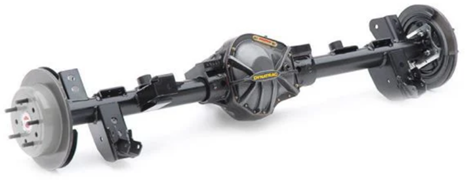SEMI-FLOAT VS FULL-FLOATUpdated 3 months ago
SEMI-FLOAT VS FULL-FLOAT |
What’s the Difference?
1. Semi-Float Axle
How it works:
- The axle shaft supports both the vehicle’s weight and rotational force (torque).
- The wheel bolts directly to the axle shaft, which runs through the outer axle housing and rides on a bearing.
Common in: ½-ton trucks, SUVs, and many daily drivers.
Pros:
- Simpler and lighter
- Cheaper to build and maintain
- Good for moderate loads and everyday use
Cons:
- Axle shaft bears vehicle weight + torque → more stress
- If the shaft breaks, wheel can come off—dangerous
- Less durable under extreme loads or off-road abuse

2. Full-Float Axle
How it works:
- The axle shaft only transmits torque, while the axle housing and hub support the vehicle's weight.
- The wheel mounts to a hub with its own bearing system; the shaft "floats" inside, hence the name.
Common in: ¾-ton, 1-ton trucks, heavy-duty work vehicles, and serious off-road builds.
Pros:
- Handles more weight and torque
- Much stronger and safer—if the shaft breaks, the wheel stays on
- Easier shaft removal for repairs
- Great for towing, heavy hauling, and off-road punishment
Cons:
- Heavier and more complex
- More expensive to build and maintain
- Slightly more drivetrain drag
How to Tell Them Apart (Quick Visual):
Feature | Semi-Float | Full-Float |
Axle Shaft Role- | Supports weight + torque | Transmits torque only |
Wheel Mounts To- | Axle shaft | Separate hub |
Shaft Removal- | Wheel comes off | Wheel stays on |
Hub Design- | Flat face, small housing | Protruding hub with bolts |
Common Lugs- | 5–6 lug (lighter duty) | 8 lug (heavy duty) |
Which One Do You Need?
Use Case | Recommended Axle |
Daily driving, light towing | Semi-float |
Towing, hauling, off-road | Full-float |
Rock crawling or overlanding | Full-float strongly preferred |
Cost-conscious builds | Semi-float can be fine if not abused |